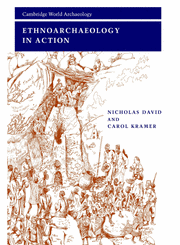Book contents
- Frontmatter
- Dedication
- Contents
- List of figures and credits
- List of tables
- Preface
- Acknowledgments
- Map
- 1 Ethnoarchaeology: its nature, origins, and history
- 2 Theorizing ethnoarchaeology and analogy
- 3 Fieldwork and ethics
- 4 Human residues: entering the archaeological context
- 5 Fauna and subsistence
- 6 Studying artifacts: functions, operating sequences, taxonomy
- 7 Style and the marking of boundaries: contrasting regional studies
- 8 Settlement: systems and patterns
- 9 Site structures and activities
- 10 Architecture
- 11 Specialist craft production and apprenticeship
- 12 Trade and exchange
- 13 Mortuary practices, status, ideology, and systems of thought
- 14 Conclusions: ethnoarchaeology in context
- Bibliography
- Index
3 - Fieldwork and ethics
Published online by Cambridge University Press: 05 March 2015
- Frontmatter
- Dedication
- Contents
- List of figures and credits
- List of tables
- Preface
- Acknowledgments
- Map
- 1 Ethnoarchaeology: its nature, origins, and history
- 2 Theorizing ethnoarchaeology and analogy
- 3 Fieldwork and ethics
- 4 Human residues: entering the archaeological context
- 5 Fauna and subsistence
- 6 Studying artifacts: functions, operating sequences, taxonomy
- 7 Style and the marking of boundaries: contrasting regional studies
- 8 Settlement: systems and patterns
- 9 Site structures and activities
- 10 Architecture
- 11 Specialist craft production and apprenticeship
- 12 Trade and exchange
- 13 Mortuary practices, status, ideology, and systems of thought
- 14 Conclusions: ethnoarchaeology in context
- Bibliography
- Index
Summary
Ethnoarchaeology … an excellent means of getting an exotic adventure holiday in a remote location … After figuring out what you think is going on with the use and discard of objects (you should never stay around long enough to master the language) you return to your desk and use these brief studies to make sweeping generalisations about what people in the past and in totally different environments must have done.
(Paul Bahn 1989: 52–3)As archaeologists began to do ethnography in the service of archaeology, they unaccountably adopted many ethnographic techniques of gathering data.
(Michael Schiffer 1978: 234)Experience has taught us that some consciousness-raising about the differences between archaeological and ethnoarchaeological fieldwork is necessary before young archaeologists are let loose to deal with live “subjects” in the field. This chapter does a little of that but is no substitute for a manual on research methods and the conduct of ethnographic and sociological fieldwork. Of these there are many (e.g., Bernard 1994; Babbie 1998; Berg 1998) to which we strongly recommend that all refer. A second purpose is to encourage critical reading of ethnoarchaeological studies. We are here concerned to establish standards rather than to criticize particular examples, and we will comment on method in discussion of the case studies treated in later chapters. What information about the production of an ethnoarchaeological work does the reader require to evaluate its conclusions?
- Type
- Chapter
- Information
- Ethnoarchaeology in Action , pp. 63 - 90Publisher: Cambridge University PressPrint publication year: 2001

